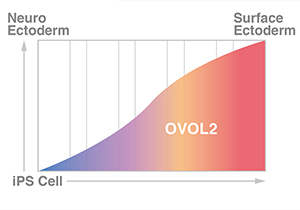In its early stages, the embryo will polarize to form cell subpopulations that go on to produce specific organs cell types. The cell subpopulations are defined by transcription factors, which induce or suppress specific genes. Despite the thousands of transcription factors in the embryo, surprising very few are needed to determine a given’s cell fate. The Shinji Masui lab, in its most recent publication in collaboration with researchers at Kyoto Prefectural University of Medicine, reports that the transcription factor OVOL2 is crucial for the differentiation of human corneal epithelium (CE) cells, the cells responsible for protecting the cornea and defections in which lead blindness in millions of people.
The discovery of OVOL2 has important implications to developmental biologists. “The ectoderm divides into the neuroectoderm and surface ectoderm,” said Masui, with CE cells coming from the surface ectoderm. Cells from the neuroectoderm, on the other hand, will lead to other parts of the eye like the retina. To investigate the regulatory role of OVOL2, the researchers overexpressed OVOL2 in human fibroblasts, which resulted in the cells taking an epithelial-like cell quality. Moreover, by overexpressing OVOL2, Masui’s team was even able to change cells with neuroectoderm fate to surface ectoderm fate. Conversely, suppressing the expression of OVOL2 caused CE cells to show qualities consistent of fibroblasts. “This suggests OVOL2 uses a reciprocally repressive mechanism,” noted Masui. In other words, OVOL2 functions to promote genes that stimulate surface ectoderm fate while at the same time it represses genes that promote neuroectoderm fate. This property suggests OVOL2 is a potential factor for direct reprogramming.
Direct reprogramming has important implications for cell therapies. For all the potential benefits of iPS cells, the time required to reprogram a cell back to the pluripotent state and then to another cell type could make the therapy ineffective if the patient is in urgent need for care, such as a disease causing rapid vision loss. Further, the reciprocally repressive mechanism of action used by OVOL2 could also lead to the identification of other key transcription factors that determine cell fate. “We can look at which genes are repressed by OVOL2 and look for transcription factors that reactivate these genes,” said Masui.

Increasing the expression of OVOL2 perturbs the ectoderm fate of an iPS cell from neuroectoderm to surface ectoderm.
Paper Information
【DOI】
http://dx.doi.org/10.1016/j.celrep.2016.04.020
【KURENAI Access URL】
http://hdl.handle.net/2433/210501
Koji Kitazawa, Takafusa Hikichi, Takahiro Nakamura, Kanae Mitsunaga, Azusa Tanaka, Masahiro Nakamura, Tatsuya Yamakawa, Shiori Furukawa, Mieko Takasaka, Naoki Goshima, Akira Watanabe, Keisuke Okita, Satoshi Kawasaki, Morio Ueno, Shigeru Kinoshita, Shinji Masui. (2016). OVOL2 Maintains the Transcriptional Program of Human Corneal Epithelium by Suppressing Epithelial-to-Mesenchymal Transition. Cell Reports, 15.





